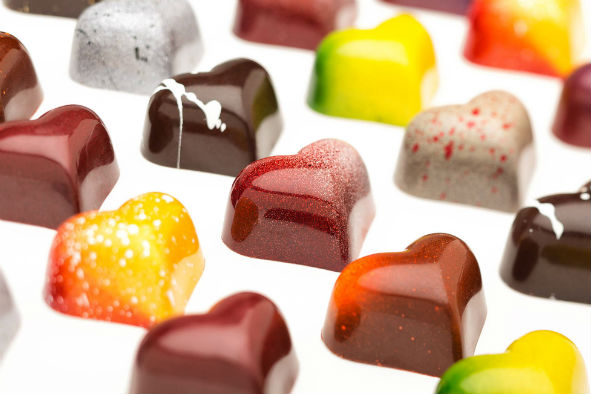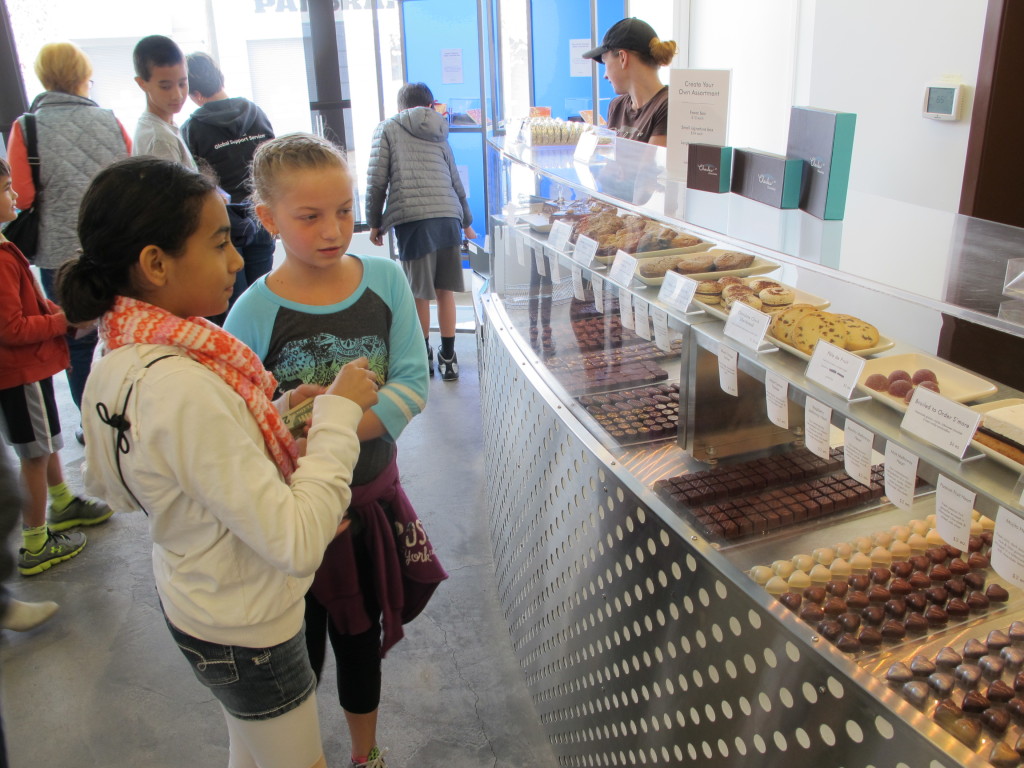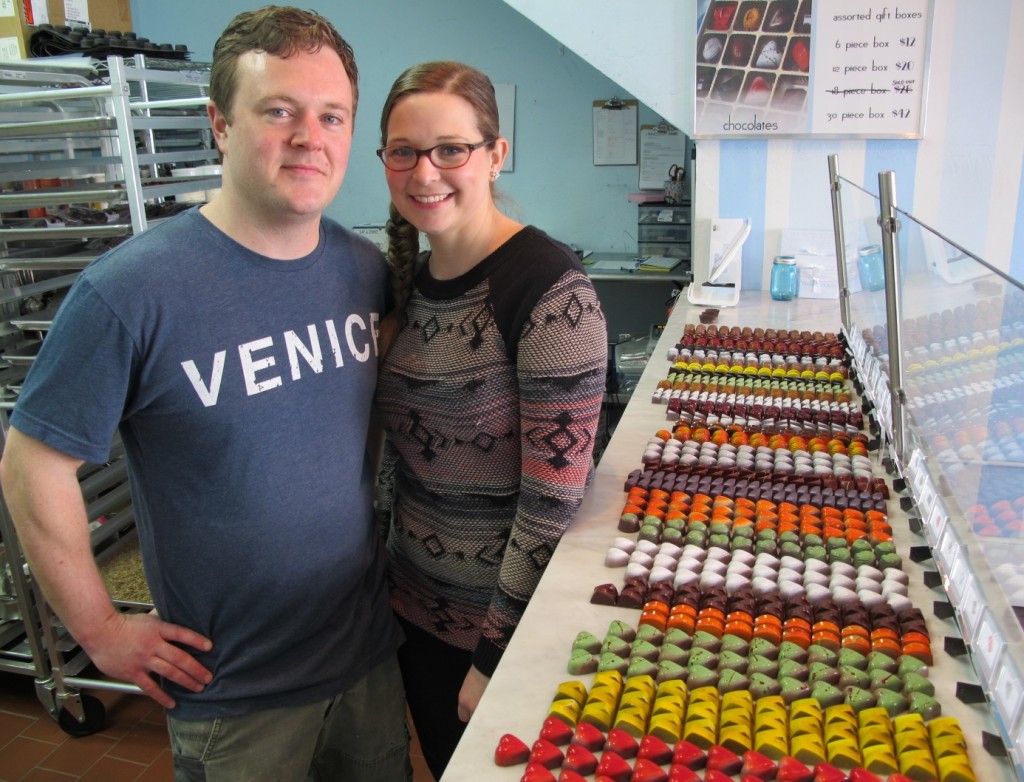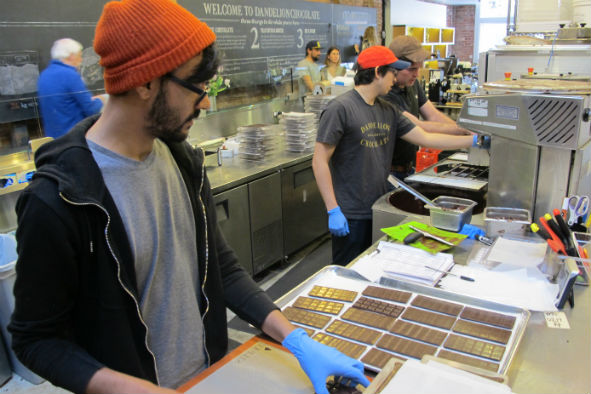It’s not mere hyperbole to boast that the epicenter of the world’s finest chocolate making is the San Francisco Bay Area. More than just the endorphin rush when culinary cunning wallops the tongue, but each confection’s aesthetic appeal – a Japanese block print, airbrushed kaleidoscopes of colors, renderings of local sites — makes them an omni-sensational experience.

Photo: Bill Strubbe
Sure there’s the obligatory trek across the Golden Gate Bridge, acting the quintes-sential tourist dork clinging to a cable car, and paying seasick homage to fabled Alcatraz, but I’m here on a gustatory pilgrimage for chocolate. Not that ho-hum Ghirardelli stuff pioneered during the Gold Rush, nor the once de rigueur holiday gift box of See’s Candy, nor a bar of Scharffen Berger long since bought out by Hersheys. No, I’m on the trail of something far more stellar and refined — the new generation of Bay Area chocolatiers and chocolate makers that have upped the ante on the world’s favorite confection.
Recchiuti Confections
It was from here at the Ferry Building at the foot of Market Street that thousands of San Franciscans fled the sweeping walls of flames in the aftermath of the 1906 quake. The weary firefighters managed to stave off the inferno, while terrified denizens jumped on anything afloat to escape across the bay.
The Ferry Building survived unscathed, and its latest incarnation is as a thriv-ing food emporium frequented by commuters and visitors alike. Amidst all these artisanal treats – Far West Fungi, McEvoy Ranch Olive Oil, Humphry Slocombe Ice Cream, and Hog Island Oyster Company – beckons Michael Rec-chiuti’s Confections (pronounced “re-cuties”), founded by Michael and his wife, Jacky.
While their signature treat is a dark, smoky caramel, also not to be missed are the divine Rose-Geranium oil swirled into caramel, capped with bittersweet chocolate; and the Spring Jasmine Tea Truffle infused in extra-bitter ganache. Michael weekly visits farmers markets for bundles of fresh lavender, tarragon and lemon verbena deployed in his signature infusions.
Elisa Prado, who has worked at Recchiuti for five years (I couldn’t resist asking how many chocolates she eats weekly; it turns out, surprisingly few….), directed me to choice pieces. The Fresh Tarragon was, well, utterly fresh tasting; the Kona Coffee a bracing mouth jolt. A clever piece with a delightful crunch was the Sesame Nougat, crafted from caramelized sesame seeds and sugar. Other unique offerings are the Red Wine Pairing Collection; and the S’ Mores Kit, with handmade vanilla bean marshmallows, homemade graham crackers, and a bittersweet chocolate bar.
Amidst San Francisco’s robust music and art scene, Elisa explained that annually Michael features a local artist on his Creativity Explored offering. This year’s, printed on burnt caramel truffles, is the San Francisco Landmarks Box, illustrated by Lance River with images of Coit Tower, Sutro Tower, Conservatory of Flow-ers and the iconic Trolley. One couldn’t ask for a better tourist gift to take back to friends and family.
Dandelion Chocolate
The Mission District is named after Mission Dolores, one of twenty-one way stations the Spaniards erected in Alta California along the El Camino Real in their quest for expansion and subjecting the Native Americans. The original mission is worth a visit, as is the tiny cemetery in its shadow.
The Mission District, long home to a thriving Hispanic and Latino population, is now ground zero for bitter gentrification skirmishes with Silicon Valley techies. In the thick of all the hip eateries, boutiques and bars, stands a sweet interlude, Dandelion. Several years ago, buddies Todd Masonis and Cameron Ring cashed out of their social media bonanza and into the chocolate business, now orchestrating their mini-platoon of Oompa-Loompas. They adhere to a simple formula: only the very finest Criollo beans pass the threshold; and their bars are composed of only two ingredients — 70% cocoa and 30% sugar.
In the United Sates, Dandelion is one of only three boutique single-source, bean-to-bar chocolate makers, allowing the nuances of the bean varietal to be fully appreciated. From stacked burlap bags employees inspect every bean, and toss out the rejects. (Commercial chocolate makers couldn’t be bothered.) Batches are then roasted in a modified coffee bean roaster, cracked, sorted again, winnowed, milled for several days in a series of stainless steel vats. Finally, small batches are tempered (which gives chocolate stability and that fa-miliar sheen), then poured into molds. After cooling, each bar is hand-wrapped in foil.
The café area, which serves up hot coco and chocolate desserts and pastries, offers informative displays of the chocolate process from beginning to end; I didn’t know that cocoa beans are fermented for a week, the acid penetrating the bean which influences the flavor of the dried bean. Some have a more earthy or smoky flavor, some are fruity, some a hint of cherry, which Dandeli-on endeavors to preserve and not obscure with vanilla, coco butter, and flavorings. Chocolate nerds, Dandelion is not to be missed.
Charles Chocolates
On the edge of the Mission District, not far from Dandelion, awaits Charles Chocolates in their new 7,600-square-foot digs (they moved across the bridge from Emeryville) which serves as café, store, and factory. Visitors are not allowed to tour the kitchen, but can view production behind the floor-to-ceiling glass walls.

Charles Chocolates (Photo: Bill Strubbe)
Behind the counter to assist me is Christine Fong, one of eight employees, who has worked here for about five years. She explains that Chuck (as in Charles) Siegel’s guiding philosophy is: “That every chocolate we make is equal to the worst ingredient put in it, so we only use the best.”
Extremely popular is their Fleur de Sel, the salt blended into the caramel for a balance of salty and sweet. I popped one into my mouth, and one wonders what exactly did we love before salted caramel (and pumpkin spice) arrived on the culinary scene.
Next in my mouth is the peanut butterfly; caramelized peanuts in sugar syrup, for a wonderful mouth crunch. The Meyer Lemon is tangy; I never had thought of chocolate and lemon as being a winning combination. Another treat is whole cashew nuts covered in a meringue of fleur de sel and cane sugar, roasted to golden brown perfection and combined with milk chocolate.
And it’s tough to ignore the chocolate bars, oozing and popping with goodies. There’s the Salty-Sweet Pecan Cherry Bar; and Candied Valencia, with roasted almonds, pistachios and pine nuts, sultanas, candies orange peel, and 65% bittersweet chocolate. And it almost skipped my notice, but in one display case it turns out that the colorful boxes are actually edible. Hah, how rude is that!
Michael Mischer Chocolates
Across the Bay Bridge, the shore of Oakland’s bucolic Lake Merritt is a wonder-ful place for a power stroll along the path, or to row a boat for an hour before lunch at one of numerous eateries; Bacheeso’s buffet of fresh Mediterranean salads and tapas is my favorite. One block east, it’s impossible to miss the historic Grand Lake Theater, its massive illuminated rooftop sign the largest rotary con-tact sign west of the Mississippi, with 2,800 colored bulbs. Designated among the nation’s top ten vintage theaters, when it opened in 1926 its neoclassical interior of faux columns and urns wowed the public. On week-ends, the historic Wurlitzer organ still rises from the orchestra to entertain before the films.
Down the block from the theatre, an unassuming storefront announces Michael Mischer Chocolates, where a very tall man of that name greets me. Born and raised in Germany, Michael entered the pastry and confection business as an apprentice to Swiss Master Pastry Chef, Andreas Haertle.
“When I first started, I didn’t know anything about confections, except that I really enjoying freshly made chocolates and pastries from local shops,” recalls the 56-year-old. “I just knew that I was happiest when in the kitchen.” After moving to California in 1984, Mischer followed his love for the craft of pro-ducing chocolates. During his research he found that chocolate made from South American Criollo beans was his favorite; now all his pralines and chocolate bars are made with single-origin chocolate: Grand Cru Couverture Sélection from the Swiss company Max Felchlin. “I think it has the best flavor profile and mouth feel.”
Since I am eating so much chocolate, each piece is cut in half (the other half stashed in my take-home bag): the Lavender Honey is subtle and sublime; the Foot Beer one reminds me of the root beers floats of my childhood. But my very favorite is the delicious and very spicy hipotle.
Lining one wall is an enticing shelf of designer chocolate bars, each studded with something wonderful: 72% Cayenne Spiced Mango, Hazelnuts, and Tof-fee and Salt. The bar that shouts out to my mouth is the milk chocolate Orange Schichimi, the tang of candied orange followed a few seconds later by the perk of the Japanese mixture of chili pepper, roasted orange peel, ginger, sesame, and sansho pepper.
Chocolatier Blue
Shortly after I arrive at Chocolate Blue, the campanile of UC Berkeley presiding over the downtown, it quickly turns into a family affair. Chris and Jennifer Blue enter with their baby boy in a stroller. I think, how fortuitous is that to have par-ents who make chocolate! It turns out that the toddler, rather than put them in his mouth, prefers to play with them. Perhaps that’s because in the display case, they look like a dazzling assortment of imperial jewels, with a regal taste to match.

Chocolatier Blue (Photo: Bill Strubbe)
Chris Blue first immersed himself in the methods of chocolate making at the French Pastry School in Chicago, then flung himself head-on into mastering the techniques of making chocolates. Chocolatier Blue opened in 2006, with his then fiancé Jessica Steve. An art major, Jessica helps design the aesthetic appeal of each of the 30 or so chocolate to hint at the flavor inside.
Chris explains that in his opinion the three finest single source bean-to-chocolate worth using are: Solstice in Salt Lake City; Ritual out of Denver; and Dandelion across the Bay Bridge. Only about 6%-9% of the world’s chocolate is the prized Criollo, which is about 5 to 10 times more expensive than the run-of-the-mill Forastero and Trinitario beans.
Each chocolate is treated like a miniature dessert with a perfected nuance of fla-vors to compliment the chocolate. As the chocolate melts in one’s mouth, the shell’s thickness is timed to balance the flavor transitions of the filling. De-pending on the season, the apples, pears, raspberries, peaches, lemons used in the collection are bought at the local farmers markets three blocks away. Every choc-olate has a pinch of fleur de sel salt from Camargue, France, to balance the sweet, sour, and bitter experience.
While the seasonal flavors such as Pineapple Basil, Grapefruit Rosemary, and Ginger Tea rotate in and out, the 75% Dark Chocolate, Expresso, Root Beer Float, Chili, and Maple Pecan are perennial. I loved the Lemon Poppy Seed, enjoying that “gritty” texture as I chewed. The Pomegranate Tarragon emerged as my favorite, incredibly fruity and tangy, with the slightest trace of herb.
Barlovento Chocolates
To locate the source of Barlovento Chocolates, you have to really, really want to find it. Just two blocks away from Oakland’s Jack London Square – there’s Yoshi’s Jazz Club, kayak and bike rentals, FDR’s Potomac Yacht tours, shops and restaurants, and weekly special events — a door in an obscure brick building opens, and I’m greeted by Peter Brydon, looking dapper with hairnets cov-ering his head and beard.
For Peter, the adventures in chocolate began in 2003 at the Berkeley Farmers market. At the Smit Ranch stall, a box of freshly dried Bing cherries beckoned. Glossy, moist, and fragrant, he ate one and was transported back to his youth in Ohio’s farm community where he fell in love with Bing cherries. At home he decided to dip the cherries in chocolate, and….well, one thing led to another. “I was always a chocolate eater,” said Peter, who formerly had been a printer, “and I started noticing the complexities of chocolate, and I wanted to learn more.”
Barlovento uses single source chocolate — cacao beans from the Carenero region in Venezuela — in their bars of Crystalized Ginger; Smit Ranch Dried Cherries; Cacao Nib; Fleur de Sel; and Candied Orange Peel, to name a few.
During the kitchen tour, I am surprised to see that each ganache cube is indi-vidually enrobed in chocolate, the transfer – a color pattern sheet – is hand placed. Further on I notice a pile of lemons being “zested” for the Meyer Lem-on chocolate. That is the first one I want to taste. Lemony indeed! I bite into one with green patterning, and the incredible fresh flavor of spearmint perme-ates my mouth; I can actually smell it. Peter explains, “We don’t use mint oil, but prepare the ganache with fresh mint from the farmer’s markets.
Another killer combo is the Venezuelan Hot Chocolate; orange zest, spice berry and star anise, the way Venezuelans prefer their hot coco. My favorites are the Cardamom and Honey and the Passion Fruit. I select a small box, including the original Bing Cherries, to take home for my dinner companions.
“Because we use such fresh ingredients, our chocolates don’t have a limited shelf life, and are best enjoyed within a week,” Peter explains. Right, like now there’s no excuse not to gobble up the whole box in one or two sittings.
